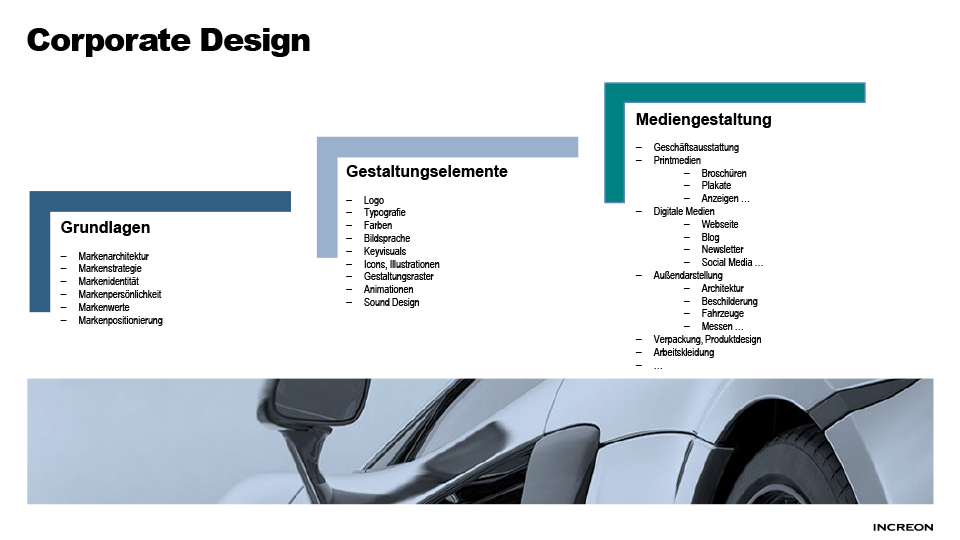

Corporate design
Corporate design is a broad term. Where does it begin, where does it end, what is mandatory, and what is open to interpretation? For us as a branding agency, corporate design is the uniform design of all visual components in print, digital, and 3D. The logo is its natural foundation.

CORPORATE DESIGN.
Holistic. Digital. And process-optimized.
In today’s global business environment, especially in B2B, corporate design plays a crucial role in a company’s success. This term extends beyond mere logo design to encompass all visual elements that shape the appearance of a brand.
Corporate design — international and intercultural.
In an increasingly networked world with diverse cultural influences, the consideration of intercultural aspects in brand design is gaining in importance. The challenge is to develop a design that not only reflects the company’s values and identity, but is also relevant and appealing in different international markets.
International markets require careful adaptation of corporate design to account for cultural differences. Colors, symbols, and visual elements can mean different things in different cultures. A successful B2B company must therefore ensure that its corporate design is relevant both locally and globally, while preserving its corporate identity.
Making the brand visible.
Corporate design stages the brand and makes it recognizable from afar. It is the uniform design of all visual components so that the brand is supported by an unmistakable appearance. In this respect, corporate design makes an important contribution to
- making internal attitudes and values recognizable to the outside world,
- creating a perceptible profile in the environment,
- achieving a continuous internal and external appearance through the clear visual relationship of all communicative measures, which promotes trust and increases credibility,
- increasing brand awareness and recognition through the variation of constant design elements, thereby improving the efficiency of long-term brand communication as well as theme-related campaigns and individual advertising measures,
- increasing the well-being, sympathy, and identification of employees through good design.
The role of logos: diversity and messages
Logos are a key element of corporate design and serve as brand identifiers. There are different types of logos, including wordmarks, figurative marks, combinations of both, and abstract symbols. Each type has its own merits and lends itself to different branding strategies. A wordmark from the company name can convey seriousness and professionalism. Figurative marks or abstract symbols are visually memorable and can represent a company’s values or field of activity.
The choice of logo type and its design influences the message communicated to customers and business partners. A modern, minimalist logo can signal inventiveness, while a classic logo can express design, tradition, and reliability. Colors, shapes, and fonts in the logo should be carefully chosen to evoke the desired emotions and associations.
We understand the task holistically and as a branding agency we come from the side of strategic creativity. It must be clear from brand strategy, brand positioning, and brand identity what the brand and corporate design should convey. Only then are development and design promising.
Corporate design in the digital world
Corporate design guidelines for print in general, trade shows, signage, and the like are now standard. The knowledge of the advantages of a consistent appearance are well known. With the Internet, digitization, and bandwidths for mobile use, with three-dimensional worlds in virtual showrooms or in the metaverse, other media formats are coming to the fore. Web, app, social media, video, audio, animations, 3D, CGI, and virtual spaces are on the agenda today, depending on the company.
For all digital media formats, the corporate design must be functionally developed and implemented in the branding agency to create a strong brand image. The user interface and the audiovisual experience of moving images, animations, 3D representations, and of spoken text plus music shape the brand experience in these formats. In many cases, they are even more vivid, emotional and above all interactive than was ever the case in the traditional print sector.
Corporate design for process optimization
Creativity meets structure and vice versa. The moment an appearance is updated holistically, the opportunity opens up to question many cherished habits. This starts with stationery, word processing, and printing, and extends to the use of presentation slides and image archives, as well as content collections and approval processes when creating media for print and digital. Because digitization has made many things easier and faster to reproduce, a corporate design relaunch can also be used to optimize processes and workflows. Well-structured templates and electronic templates in combination with appropriate training of users by the B2B branding agency simplify the work, facilitate the application, and reinforce the brand image.
Corporate design in the B2B sector
Corporate design in B2B involves much more than just a logo. It encompasses the entire visual identity of a company, which must be relevant and culturally sensitive in international markets. Intercultural aspects are becoming increasingly important in light of global business activities.
Logos play a key role in corporate design by conveying identification and messages. Different types of logos can communicate different emotions and values.
In today’s digital world, companies need to ensure that their corporate design has a consistent and effective presence not only in traditional media, but also in digital formats. A well-thought-out corporate design can not only strengthen the brand, but also optimize processes and promote employee identification.






